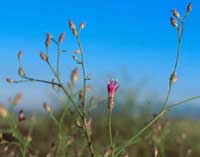Squarrose knapweed
Centaurea virgata Lam. var. squarrosa (Willd.) Boiss.
Keys to Identification
- Squarrose knapweed is a competitive rangeland weed
- Small pink to rose flowers
- Curved bracts
- Seedheads drop from the plant
This information courtesy of the Colorado Natural Areas Program
Family
Sunflower (Asteraceae)
Other Names
None widely accepted.
USDA Code
CEVIS
Legal Status
Colorado Noxious Weed List A
New in Colorado – call your county weed supervisor if you find this plant!
Identification
Lifecycle
Perennial
Growth form
Forb
Flower
Flower heads are small, numerous, and have 4-8 rose or pink colored flowers. The flower bract tips are recurved (bending downward) or spreading, with the terminal spine longer than the lateral spines on each bract.
Leaves
Lower leaves are deeply dissected, upper leaves are bract-like.
Stems
Mature plants are typically between 12-18 in tall with highly branched stems.
Roots
Taproot
Seedling
Seedlings have deeply indented, gray-green leaves.
Similar Species
Exotics
Often confused with diffuse knapweed (Centaurea diffusa), but differs principally in the fact that it is a true perennial, and bracts are recurved. Unlike diffuse knapweed, seed heads of squarrose knapweed are highly deciduous, falling off the stems soon after seeds mature.
Natives
None known.
Impacts
Agricultural
an affect rangeland productivity by displacing desirable native species.
Ecological
Squarrose knapweed is a highly competitive weed that can displace native rangeland plants. It aggressively grows in dry disturbed areas, particularly in sand or cinders such as roadsides or cinderpits. Like other knapweed species, squarrose knapweed releases allelopathic chemicals that inhibit the growth of other plants.
Habitat and Distribution
General requirements
Squarrose knapweed is found on plains, rangelands, and forested benchlands. In Utah, squarrose knapweed grows mostly in big sagebrush-bunchgrass rangeland, but it is also found at higher and lower elevations in juniper and salt desert range, respectively (Roché 1999). It is generally found on light, dry, porous soils. It prefers open habitats to shaded areas. Squarrose knapweed is not common on cultivated lands or irrigated pasture because it cannot tolerate cultivation or excessive moisture.
Distribution
Not yet widespread in the western United States, but established in California, Utah, Oregon and Washington.
Historical
Native to Asia.
Biology/Ecology
Life cycle
Squarrose knapweed may spend several years as a rosette before it bolts and produces seeds (Roche and Roche 1991). Once it has matured, squarrose knapweed may continue to flower and produce seeds for several years. Squarrose knapweed flowers from June through August. Seed heads are highly deciduous and fall off the stems soon after seeds mature.
Mode of reproduction
Seed
Seed production
Each seed head produces 3-4 seeds.
Seed bank
Seeds may remain viable in the soil for several years.
Dispersal
The spring seed heads readily stick to animal fur and vehicle tires, thereby promoting long-distance dispersal.
References
Beck, G. K. 1997. Natural resources series, diffuse knapweed. Colorado State University Cooperative Extension. Internet 05/05/98. Available: http://ozma.jefferson.co.us/dpt/openspac/weed/dfknapwd.htm
Roché B.F. Jr. and C.T. Roché. 1991. Identification, introduction, distribution, ecology, and economics of Centaurea species. In: Noxious Range Weeds. Westview Press. Boulder. pg. 274.
Roché, C.T. 1999. Squarrose knapweed. In: R.L. Sheley and J.K. Petroff (eds.) Biology and management of noxious rangeland weeds. Oregon State University Press, Corvallis. pg. 362-371.
Watson, A.K., and A.J. Renney. 1974. The biology of Canadian weeds Centaurea diffusa and C. maculosa. Canadian Journal of Plant Science 54:687-701.
Whitson, T.D.(ed.), L.C. Burrill, S.A. Dewey, D.W. Cudney, B.E. Nelson, R.D. Lee, R. Parker. 1996. Squarrose knapweed. Weeds of the West. Western Society of Weed Science, in cooperation with the Western United States Land Grant Universities Cooperative Extension Services, Newark CA. pg. 97.
Youtie, B. 1997. Weed control as the first step in protecting and restoring native plant communities on northeast Oregon natural areas. Conservation and Management of Native Plants and Fungi. Native Plant Society of Oregon, Corvallis, Oregon. pages 78-82.

